fuel pressure SUBARU WRX 2018 Owners Manual
[x] Cancel search | Manufacturer: SUBARU, Model Year: 2018, Model line: WRX, Model: SUBARU WRX 2018Pages: 578, PDF Size: 33.21 MB
Page 29 of 578
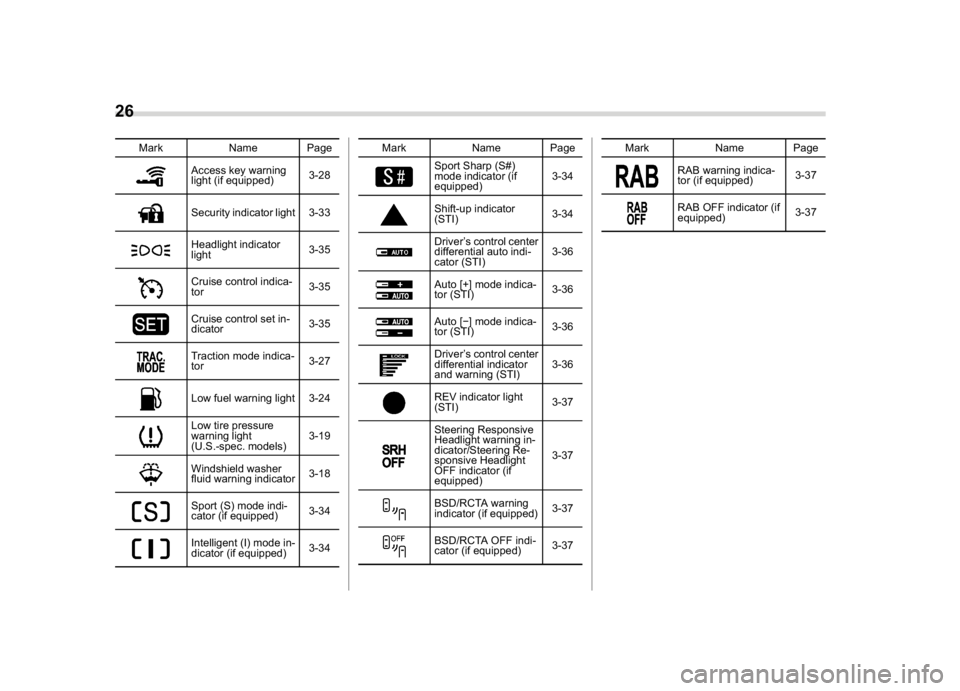
(28,1)
北米Model "A1700BE-B" EDITED: 2017/ 10/ 11
Mark Name Page
Access key warning
light (if equipped)3-28Security indicator light 3-33Headlight indicator
light3-35Cruise control indica-
tor3-35Cruise control set in-
dicator3-35Traction mode indica-
tor3-27Low fuel warning light 3-24Low tire pressure
warning light
(U.S.-spec. models)3-19Windshield washer
fluid warning indicator3-18Sport (S) mode indi-
cator (if equipped)3-34Intelligent (I) mode in-
dicator (if equipped)3-34Mark Name Page
Sport Sharp (S#)
mode indicator (if
equipped)3-34Shift-up indicator
(STI)3-34Driver’s control center
differential auto indi-
cator (STI)3-36Auto [+] mode indica-
tor (STI)3-36Auto [�] mode indica-
tor (STI)3-36Driver’s control center
differential indicator
and warning (STI)3-36REV indicator light
(STI)3-37Steering Responsive
Headlight warning in-
dicator/Steering Re-
sponsive Headlight
OFF indicator (if
equipped)3-37BSD/RCTA warning
indicator (if equipped)3-37BSD/RCTA OFF indi-
cator (if equipped)3-37Mark Name Page
RAB warning indica-
tor (if equipped)3-37RAB OFF indicator (if
equipped)3-37
26
Page 138 of 578
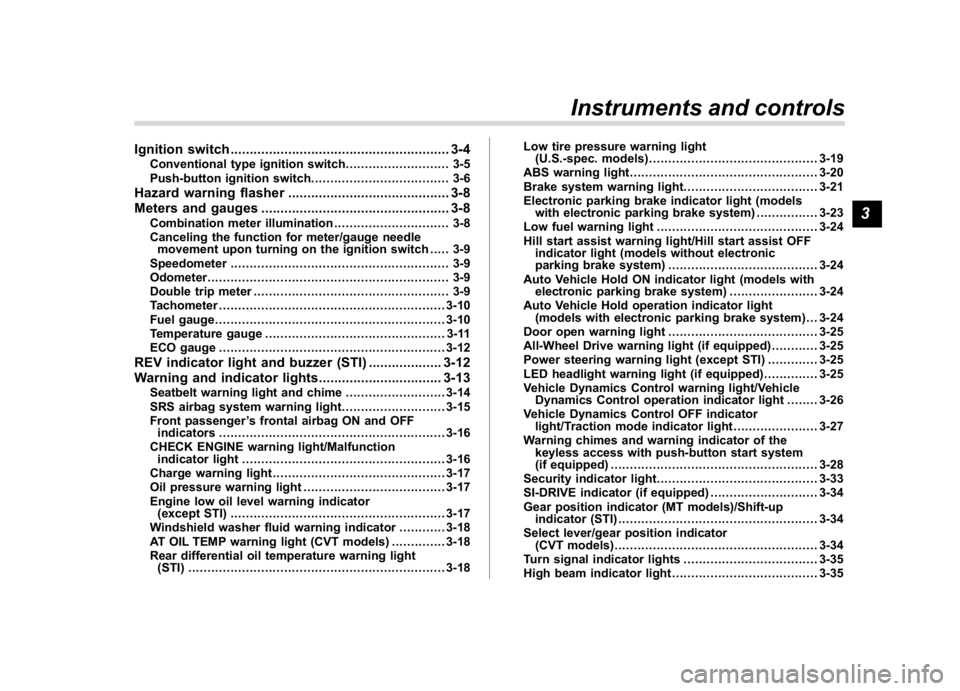
(143,1)
北米Model "A1700BE-B" EDITED: 2017/ 10/ 11
Ignition switch.........................................................3-4
Conventional type ignition switch........................... 3-5
Push-button ignition switch.................................... 3-6
Hazard warning flasher..........................................3-8
Meters and gauges.................................................3-8
Combination meter illumination.............................. 3-8
Canceling the function for meter/gauge needle
movement upon turning on the ignition switch..... 3-9
Speedometer......................................................... 3-9
Odometer............................................................... 3-9
Double trip meter................................................... 3-9
Tachometer...........................................................3-10
Fuel gauge............................................................3-10
Temperature gauge............................................... 3-11
ECO gauge...........................................................3-12
REV indicator light andbuzzer (STI)...................3-12
Warning and indicatorlights................................3-13
Seatbelt warning light and chime..........................3-14
SRS airbag system warning light...........................3-15
Front passenger’s frontal airbag ON and OFF
indicators...........................................................3-16
CHECK ENGINE warning light/Malfunction
indicator light.....................................................3-16
Charge warning light.............................................3-17
Oil pressure warning light.....................................3-17
Engine low oil level warning indicator
(except STI)........................................................3-17
Windshield washer fluid warning indicator............3-18
AT OIL TEMP warning light (CVT models)..............3-18
Rear differential oil temperature warning light
(STI)...................................................................3-18Low tire pressure warning light
(U.S.-spec. models)............................................3-19
ABS warning light.................................................3-20
Brake system warning light...................................3-21
Electronic parking brake indicator light (models
with electronic parking brake system)................3-23
Low fuel warning light..........................................3-24
Hill start assist warning light/Hill start assist OFF
indicator light (models without electronic
parking brake system).......................................3-24
Auto Vehicle Hold ON indicator light (models with
electronic parking brake system).......................3-24
Auto Vehicle Hold operation indicator light
(models with electronic parking brake system) ... 3-24
Door open warning light.......................................3-25
All-Wheel Drive warning light (if equipped) ............3-25
Power steering warning light (except STI) .............3-25
LED headlight warning light (if equipped)..............3-25
Vehicle Dynamics Control warning light/Vehicle
Dynamics Control operation indicator light........3-26
Vehicle Dynamics Control OFF indicator
light/Traction mode indicator light......................3-27
Warning chimes and warning indicator of the
keyless access with push-button start system
(if equipped)......................................................3-28
Security indicator light..........................................3-33
SI-DRIVE indicator (if equipped)............................3-34
Gear position indicator (MT models)/Shift-up
indicator (STI)....................................................3-34
Select lever/gear position indicator
(CVT models).....................................................
3-34
Turn signal indicator lights...................................3-35
High beam indicator light......................................3-35
Instruments and controls
3
Page 150 of 578
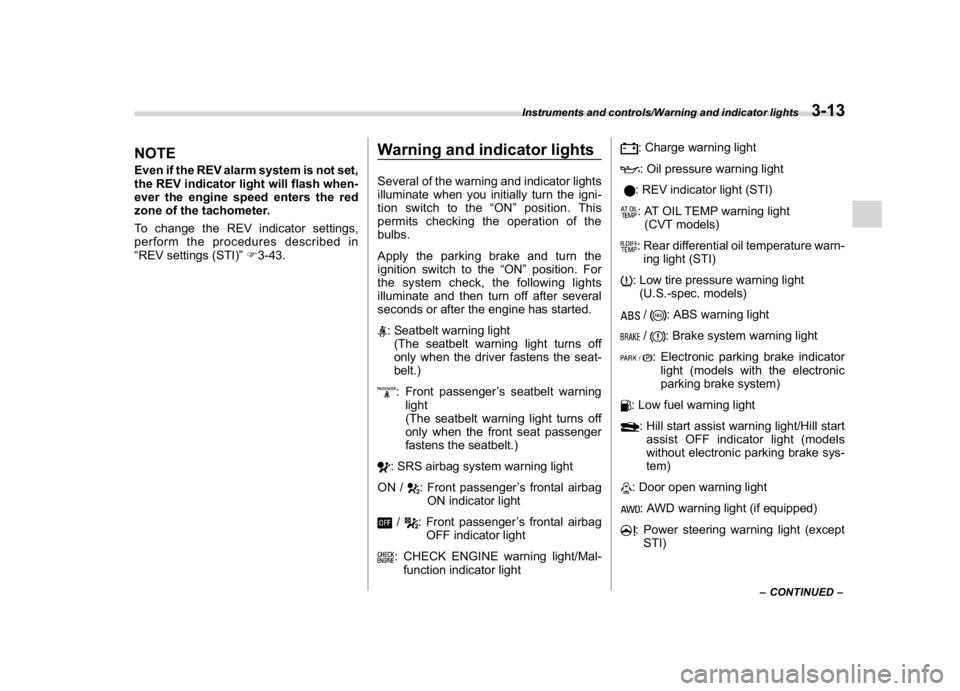
(155,1)
北米Model "A1700BE-B" EDITED: 2017/ 10/ 11
NOTEEven if the REV alarm system is not set,
the REV indicator light will flash when-
ever the engine speed enters the red
zone of the tachometer.
To change the REV indicator settings,
perform the procedures described in
“REV settings (STI)”F3-43.
Warning and indicator lightsSeveral of the warning and indicator lights
illuminate when you initially turn the igni-
tion switch to the“ON”position. This
permits checking the operation of the
bulbs.
Apply the parking brake and turn the
ignition switch to the“ON”position. For
the system check, the following lights
illuminate and then turn off after several
seconds or after the engine has started.: Seatbelt warning light
(The seatbelt warning light turns off
only when the driver fastens the seat-
belt.): Front passenger’s seatbelt warning
light
(The seatbelt warning light turns off
only when the front seat passenger
fastens the seatbelt.): SRS airbag system warning light
ON /
: Front passenger’s frontal airbag
ON indicator light
/
: Front passenger’s frontal airbag
OFF indicator light
: CHECK ENGINE warning light/Mal-
function indicator light
: Charge warning light: Oil pressure warning light: REV indicator light (STI): AT OIL TEMP warning light
(CVT models): Rear differential oil temperature warn-
ing light (STI): Low tire pressure warning light
(U.S.-spec. models)/
: ABS warning light
/
: Brake system warning light: Electronic parking brake indicator
light (models with the electronic
parking brake system)
: Low fuel warning light: Hill start assist warning light/Hill start
assist OFF indicator light (models
without electronic parking brake sys-
tem): Door open warning light: AWD warning light (if equipped): Power steering warning light (except
STI)
–CONTINUED–
Instruments and controls/Warning and indicator lights
3-13
3
Page 154 of 578
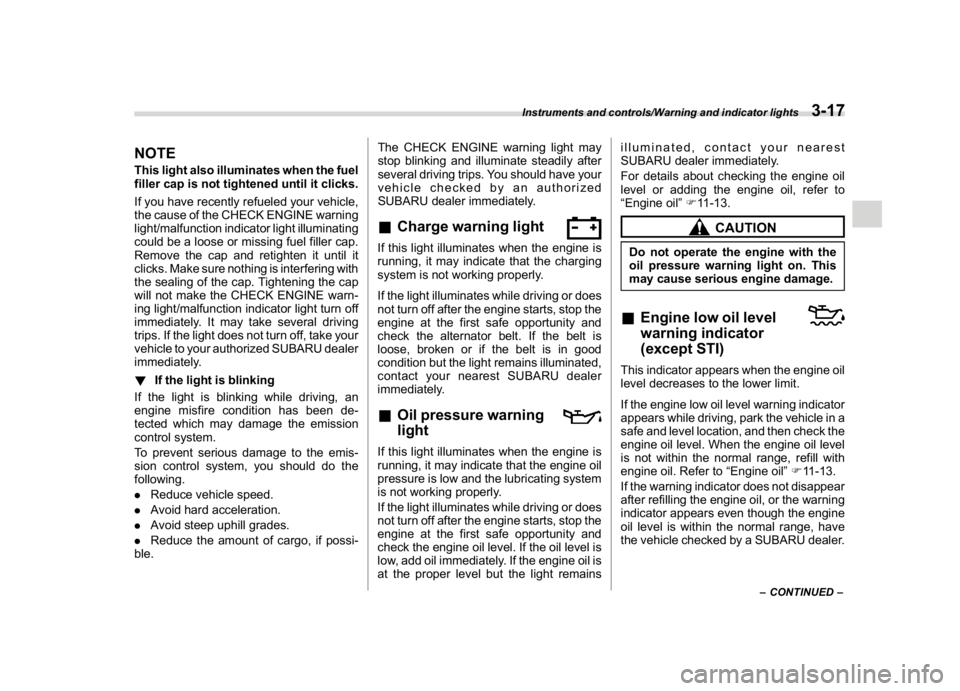
(159,1)
北米Model "A1700BE-B" EDITED: 2017/ 10/ 11
NOTEThis light also illuminates when the fuel
filler cap is not tightened until it clicks.
If you have recently refueled your vehicle,
the cause of the CHECK ENGINE warning
light/malfunction indicator light illuminating
could be a loose or missing fuel filler cap.
Remove the cap and retighten it until it
clicks. Make sure nothing is interfering with
the sealing of the cap. Tightening the cap
will not make the CHECK ENGINE warn-
ing light/malfunction indicator light turn off
immediately. It may take several driving
trips. If the light does not turn off, take your
vehicle to your authorized SUBARU dealer
immediately.
!If the light is blinking
If the light is blinking while driving, an
engine misfire condition has been de-
tected which may damage the emission
control system.
To prevent serious damage to the emis-
sion control system, you should do the
following.
.Reduce vehicle speed.
.Avoid hard acceleration.
.Avoid steep uphill grades.
.Reduce the amount of cargo, if possi-
ble.The CHECK ENGINE warning light may
stop blinking and illuminate steadily after
several driving trips. You should have your
vehicle checked by an authorized
SUBARU dealer immediately.
&Charge warning lightIf this light illuminates when the engine is
running, it may indicate that the charging
system is not working properly.
If the light illuminates while driving or does
not turn off after the engine starts, stop the
engine at the first safe opportunity and
check the alternator belt. If the belt is
loose, broken or if the belt is in good
condition but the light remains illuminated,
contact your nearest SUBARU dealer
immediately.&Oil pressure warning
lightIf this light illuminates when the engine is
running, it may indicate that the engine oil
pressure is low and the lubricating system
is not working properly.
If the light illuminates while driving or does
not turn off after the engine starts, stop the
engine at the first safe opportunity and
check the engine oil level. If the oil level is
low, add oil immediately. If the engine oil is
at the proper level but the light remainsilluminated, contact your nearest
SUBARU dealer immediately.
For details about checking the engine oil
level or adding the engine oil, refer to
“Engine oil”F11-13.
CAUTION
Do not operate the engine with the
oil pressure warning light on. This
may cause serious engine damage.&Engine low oil level
warning indicator
(except STI)This indicator appears when the engine oil
level decreases to the lower limit.
If the engine low oil level warning indicator
appears while driving, park the vehicle in a
safe and level location, and then check the
engine oil level. When the engine oil level
is not within the normal range, refill with
engine oil. Refer to“Engine oil”F11-13.
If the warning indicator does not disappear
after refilling the engine oil, or the warning
indicator appears even though the engine
oil level is within the normal range, have
the vehicle checked by a SUBARU dealer.
–CONTINUED–
Instruments and controls/Warning and indicator lights
3-17
3
Page 156 of 578
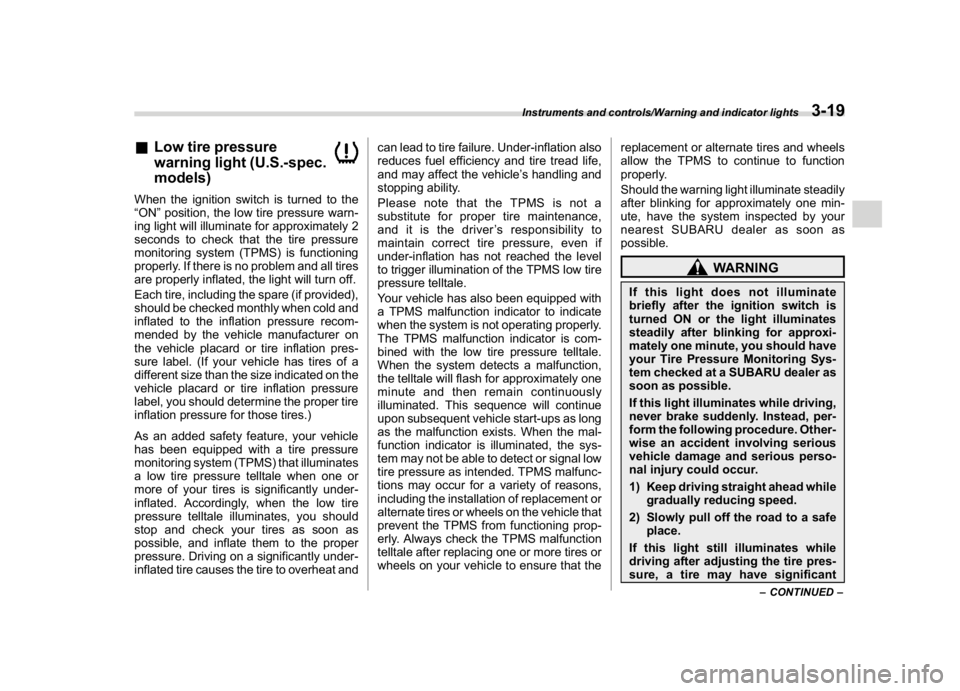
(161,1)
北米Model "A1700BE-B" EDITED: 2017/ 10/ 11
&Low tire pressure
warning light (U.S.-spec.
models)When the ignition switch is turned to the
“ON”position, the low tire pressure warn-
ing light will illuminate for approximately 2
seconds to check that the tire pressure
monitoring system (TPMS) is functioning
properly. If there is no problem and all tires
are properly inflated, the light will turn off.
Each tire, including the spare (if provided),
should be checked monthly when cold and
inflated to the inflation pressure recom-
mended by the vehicle manufacturer on
the vehicle placard or tire inflation pres-
sure label. (If your vehicle has tires of a
different size than the size indicated on the
vehicle placard or tire inflation pressure
label, you should determine the proper tire
inflation pressure for those tires.)
As an added safety feature, your vehicle
has been equipped with a tire pressure
monitoring system (TPMS) that illuminates
a low tire pressure telltale when one or
more of your tires is significantly under-
inflated. Accordingly, when the low tire
pressure telltale illuminates, you should
stop and check your tires as soon as
possible, and inflate them to the proper
pressure. Driving on a significantly under-
inflated tire causes the tire to overheat andcan lead to tire failure. Under-inflation also
reduces fuel efficiency and tire tread life,
and may affect the vehicle’s handling and
stopping ability.
Please note that the TPMS is not a
substitute for proper tire maintenance,
and it is the driver’s responsibility to
maintain correct tire pressure, even if
under-inflation has not reached the level
to trigger illumination of the TPMS low tire
pressure telltale.
Your vehicle has also been equipped with
a TPMS malfunction indicator to indicate
when the system is not operating properly.
The TPMS malfunction indicator is com-
bined with the low tire pressure telltale.
When the system detects a malfunction,
the telltale will flash for approximately one
minute and then remain continuously
illuminated. This sequence will continue
upon subsequent vehicle start-ups as long
as the malfunction exists. When the mal-
function indicator is illuminated, the sys-
tem may not be able to detect or signal low
tire pressure as intended. TPMS malfunc-
tions may occur for a variety of reasons,
including the installation of replacement or
alternate tires or wheels on the vehicle that
prevent the TPMS from functioning prop-
erly. Always check the TPMS malfunction
telltale after replacing one or more tires or
wheels on your vehicle to ensure that thereplacement or alternate tires and wheels
allow the TPMS to continue to function
properly.
Should the warning light illuminate steadily
after blinking for approximately one min-
ute, have the system inspected by your
nearest SUBARU dealer as soon as
possible.
WARNING
If this light does not illuminate
briefly after the ignition switch is
turned ON or the light illuminates
steadily after blinking for approxi-
mately one minute, you should have
your Tire Pressure Monitoring Sys-
tem checked at a SUBARU dealer as
soon as possible.
If this light illuminates while driving,
never brake suddenly. Instead, per-
form the following procedure. Other-
wise an accident involving serious
vehicle damage and serious perso-
nal injury could occur.
1) Keep driving straight ahead while
gradually reducing speed.
2) Slowly pull off the road to a safe
place.
If this light still illuminates while
driving after adjusting the tire pres-
sure, a tire may have significant
–CONTINUED–
Instruments and controls/Warning and indicator lights
3-19
3
Page 185 of 578
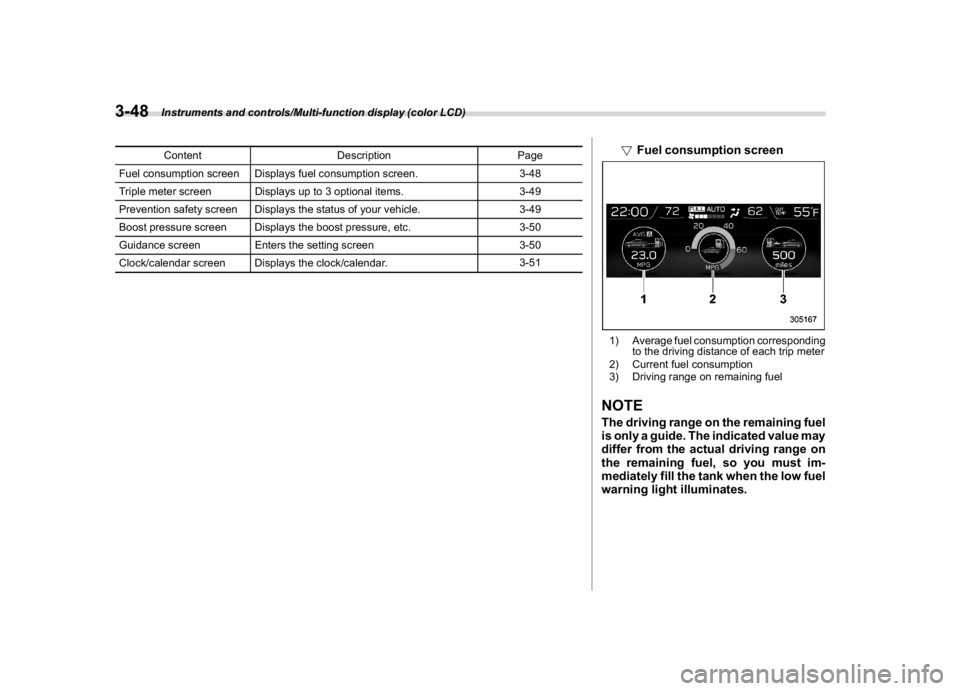
(190,1)
北米Model "A1700BE-B" EDITED: 2017/ 10/ 11
Content Description Page
Fuel consumption screen Displays fuel consumption screen. 3-48
Triple meter screen Displays up to 3 optional items. 3-49
Prevention safety screen Displays the status of your vehicle. 3-49
Boost pressure screen Displays the boost pressure, etc. 3-50
Guidance screen Enters the setting screen 3-50
Clock/calendar screen Displays the clock/calendar.3-51
!Fuel consumption screen1) Average fuel consumption corresponding
to the driving distance of each trip meter
2) Current fuel consumption
3) Driving range on remaining fuelNOTEThe driving range on the remaining fuel
is only a guide. The indicated value may
differ from the actual driving range on
the remaining fuel, so you must im-
mediately fill the tank when the low fuel
warning light illuminates.
Instruments and controls/Multi-function display (color LCD)
3-48
Page 186 of 578
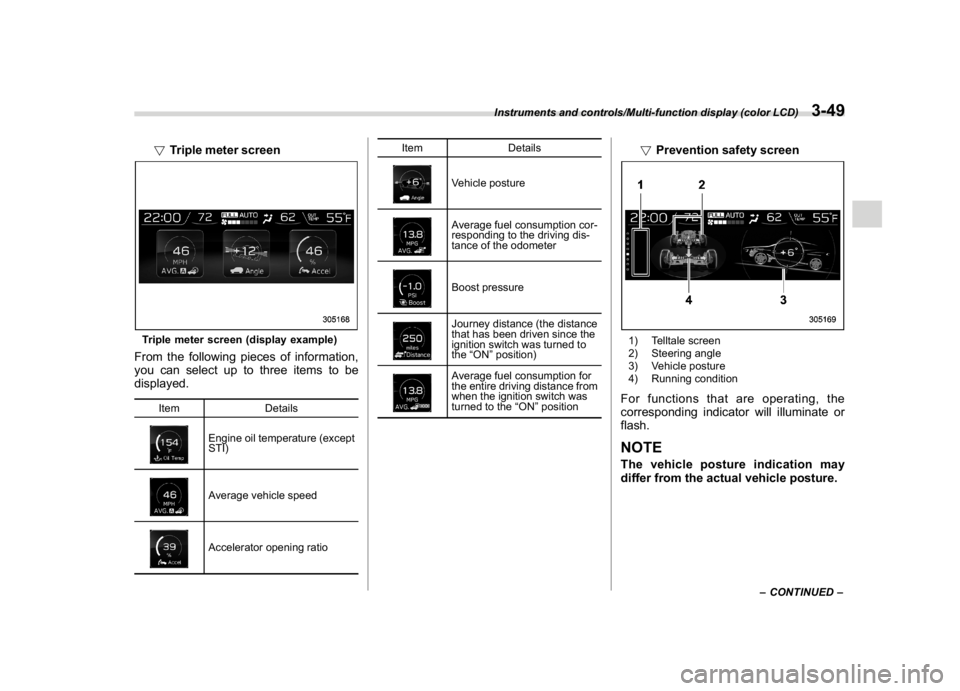
(191,1)
北米Model "A1700BE-B" EDITED: 2017/ 10/ 11
!Triple meter screenTriple meter screen (display example)From the following pieces of information,
you can select up to three items to be
displayed.
Item Details
Engine oil temperature (except
STI)Average vehicle speedAccelerator opening ratioItem Details
Vehicle postureAverage fuel consumption cor-
responding to the driving dis-
tance of the odometerBoost pressureJourney distance (the distance
that has been driven since the
ignition switch was turned to
the“ON”position)Average fuel consumption for
the entire driving distance from
when the ignition switch was
turned to the“ON”position
!Prevention safety screen1) Telltale screen
2) Steering angle
3) Vehicle posture
4) Running conditionFor functions that are operating, the
corresponding indicator will illuminate or
flash.NOTEThe vehicle posture indication may
differ from the actual vehicle posture.
–CONTINUED–
Instruments and controls/Multi-function display (color LCD)
3-49
3
Page 350 of 578
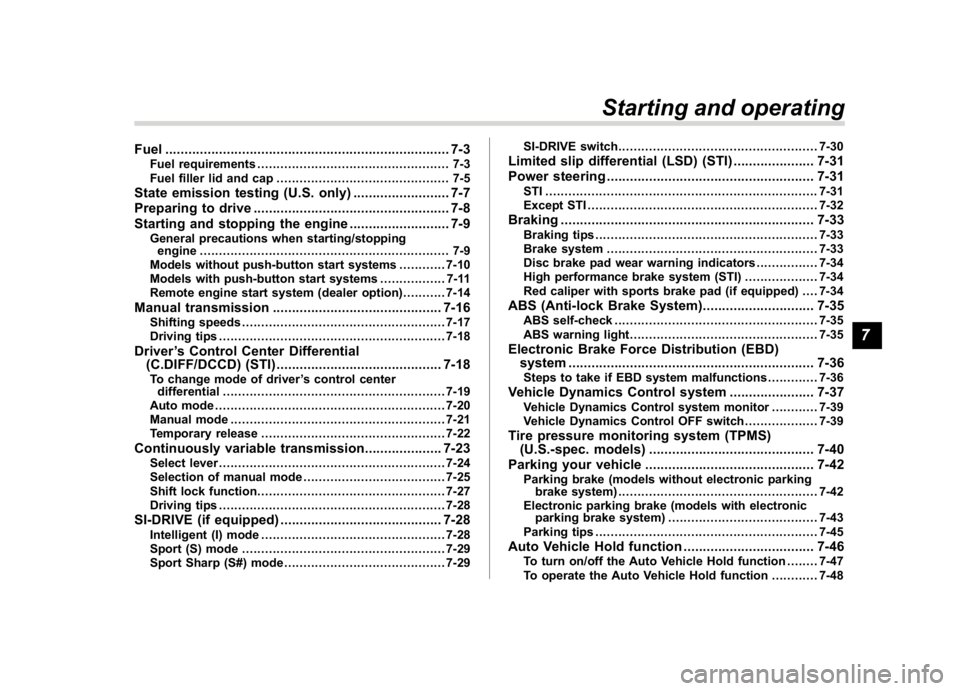
(363,1)
北米Model "A1700BE-B" EDITED: 2017/ 10/ 11
Fuel..........................................................................7-3
Fuel requirements.................................................. 7-3
Fuel filler lid and cap............................................. 7-5
State emission testing (U.S.only).........................7-7
Preparing to drive...................................................7-8
Starting and stopping theengine..........................7-9
General precautions when starting/stopping
engine................................................................. 7-9
Models without push-button start systems............7-10
Models with push-button start systems ................. 7-11
Remote engine start system (dealer option)...........7-14
Manual transmission............................................7-16
Shifting speeds.....................................................7-17
Driving tips...........................................................7-18
Driver’s Control Center Differential
(C.DIFF/DCCD) (STI)...........................................7-18
To change mode of driver’s control center
differential..........................................................7-19
Auto mode............................................................7-20
Manual mode........................................................7-21
Temporary release................................................7-22
Continuously variable transmission....................7-23
Select lever...........................................................7-24
Selection of manual mode.....................................7-25
Shift lock function.................................................7-27
Driving tips...........................................................7-28
SI-DRIVE (if equipped)..........................................7-28
Intelligent (I) mode................................................7-28
Sport (S) mode.....................................................7-29
Sport Sharp (S#) mode..........................................7-29SI-DRIVE switch....................................................7-30
Limited slip differential (LSD)(STI).....................7-31
Power steering......................................................7-31
STI .......................................................................7-31
Except STI............................................................7-32
Braking..................................................................7-33
Braking tips..........................................................7-33
Brake system.......................................................7-33
Disc brake pad wear warning indicators................7-34
High performance brake system (STI)...................7-34
Red caliper with sports brake pad (if equipped) .... 7-34
ABS (Anti-lock BrakeSystem).............................7-35
ABS self-check.....................................................7-35
ABS warning light.................................................7-35
Electronic Brake Force Distribution (EBD)
system................................................................7-36
Steps to take if EBD system malfunctions .............7-36
Vehicle Dynamics Controlsystem......................7-37
Vehicle Dynamics Control system monitor ............7-39
Vehicle Dynamics Control OFF switch...................7-39
Tire pressure monitoring system (TPMS)
(U.S.-spec. models)...........................................7-40
Parking your vehicle............................................7-42
Parking brake (models without electronic parking
brake system)....................................................7-42
Electronic parking brake (models with electronic
parking brake system).......................................7-43
Parking tips..........................................................7-45
Auto Vehicle Holdfunction..................................7-46
To turn on/off the Auto Vehicle Hold function........7-47
To operate the Auto Vehicle Hold function ............7-48
Starting and operating
7
Page 355 of 578
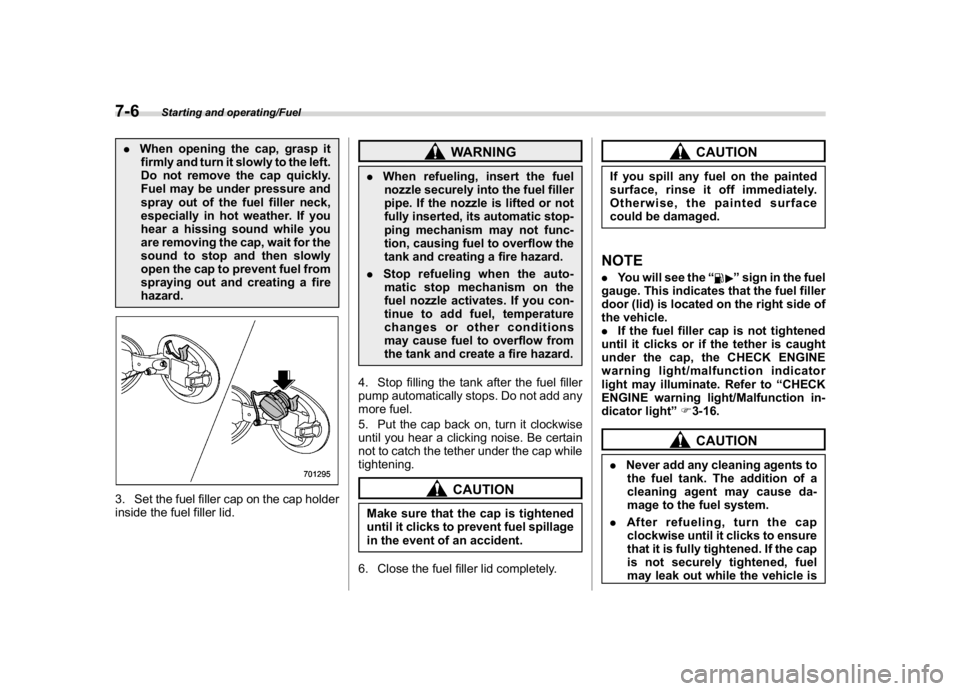
(368,1)
北米Model "A1700BE-B" EDITED: 2017/ 10/ 11
.When opening the cap, grasp it
firmly and turn it slowly to the left.
Do not remove the cap quickly.
Fuel may be under pressure and
spray out of the fuel filler neck,
especially in hot weather. If you
hear a hissing sound while you
are removing the cap, wait for the
sound to stop and then slowly
open the cap to prevent fuel from
spraying out and creating a fire
hazard.3. Set the fuel filler cap on the cap holder
inside the fuel filler lid.
WARNING
.When refueling, insert the fuel
nozzle securely into the fuel filler
pipe. If the nozzle is lifted or not
fully inserted, its automatic stop-
ping mechanism may not func-
tion, causing fuel to overflow the
tank and creating a fire hazard.
.Stop refueling when the auto-
matic stop mechanism on the
fuel nozzle activates. If you con-
tinue to add fuel, temperature
changes or other conditions
may cause fuel to overflow from
the tank and create a fire hazard.
4. Stop filling the tank after the fuel filler
pump automatically stops. Do not add any
more fuel.
5. Put the cap back on, turn it clockwise
until you hear a clicking noise. Be certain
not to catch the tether under the cap while
tightening.
CAUTION
Make sure that the cap is tightened
until it clicks to prevent fuel spillage
in the event of an accident.
6. Close the fuel filler lid completely.
CAUTION
If you spill any fuel on the painted
surface, rinse it off immediately.
Otherwise, the painted surface
could be damaged.NOTE.You will see the“
”sign in the fuel
gauge. This indicates that the fuel filler
door (lid) is located on the right side of
the vehicle.
.If the fuel filler cap is not tightened
until it clicks or if the tether is caught
under the cap, the CHECK ENGINE
warning light/malfunction indicator
light may illuminate. Refer to“CHECK
ENGINE warning light/Malfunction in-
dicator light”F3-16.
CAUTION
.Never add any cleaning agents to
the fuel tank. The addition of a
cleaning agent may cause da-
mage to the fuel system.
.After refueling, turn the cap
clockwise until it clicks to ensure
that it is fully tightened. If the cap
is not securely tightened, fuel
may leak out while the vehicle is
Starting and operating/Fuel
7-6
Page 427 of 578
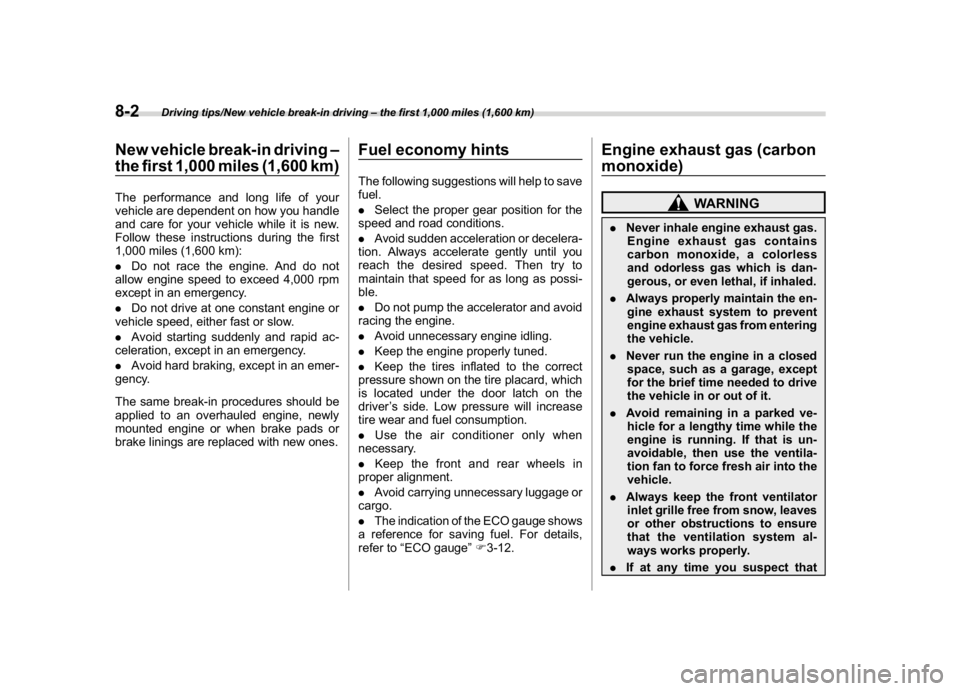
(442,1)
北米Model "A1700BE-B" EDITED: 2017/ 10/ 11
New vehicle break-in driving–
the first 1,000 miles (1,600 km)The performance and long life of your
vehicle are dependent on how you handle
and care for your vehicle while it is new.
Follow these instructions during the first
1,000 miles (1,600 km):
.Do not race the engine. And do not
allow engine speed to exceed 4,000 rpm
except in an emergency.
.Do not drive at one constant engine or
vehicle speed, either fast or slow.
.Avoid starting suddenly and rapid ac-
celeration, except in an emergency.
.Avoid hard braking, except in an emer-
gency.
The same break-in procedures should be
applied to an overhauled engine, newly
mounted engine or when brake pads or
brake linings are replaced with new ones.
Fuel economy hintsThe following suggestions will help to save
fuel.
.Select the proper gear position for the
speed and road conditions.
.Avoid sudden acceleration or decelera-
tion. Always accelerate gently until you
reach the desired speed. Then try to
maintain that speed for as long as possi-
ble.
.Do not pump the accelerator and avoid
racing the engine.
.Avoid unnecessary engine idling.
.Keep the engine properly tuned.
.Keep the tires inflated to the correct
pressure shown on the tire placard, which
is located under the door latch on the
driver’s side. Low pressure will increase
tire wear and fuel consumption.
.Use the air conditioner only when
necessary.
.Keep the front and rear wheels in
proper alignment.
.Avoid carrying unnecessary luggage or
cargo.
.The indication of the ECO gauge shows
a reference for saving fuel. For details,
refer to“ECO gauge”F3-12.
Engine exhaust gas (carbon
monoxide)
WARNING
.Never inhale engine exhaust gas.
Engine exhaust gas contains
carbon monoxide, a colorless
and odorless gas which is dan-
gerous, or even lethal, if inhaled.
.Always properly maintain the en-
gine exhaust system to prevent
engine exhaust gas from entering
the vehicle.
.Never run the engine in a closed
space, such as a garage, except
for the brief time needed to drive
the vehicle in or out of it.
.Avoid remaining in a parked ve-
hicle for a lengthy time while the
engine is running. If that is un-
avoidable, then use the ventila-
tion fan to force fresh air into the
vehicle.
.Always keep the front ventilator
inlet grille free from snow, leaves
or other obstructions to ensure
that the ventilation system al-
ways works properly.
.If at any time you suspect that
Driving tips/New vehicle break-in driving–the first 1,000 miles (1,600 km)
8-2